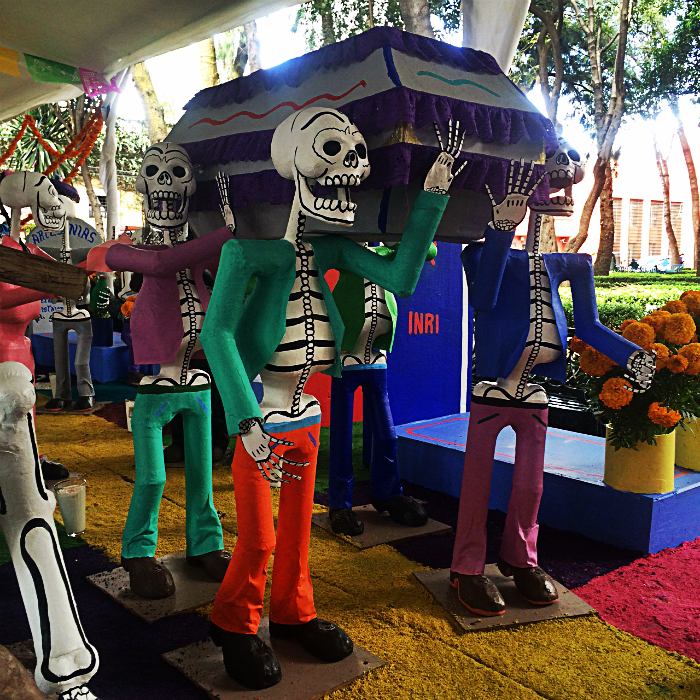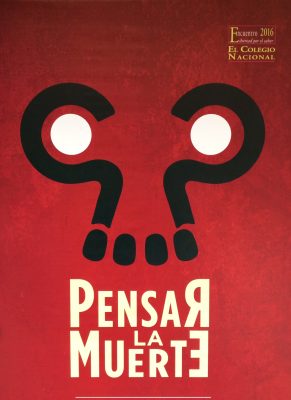
Paper calaveras carrying a coffin. Day of the Dead in Mexico. Author's image used by Global Voices with permission.
Every year in Mexico, people commemorate the Day of the Dead [1], or el Día de Muertos, on November 2. The Catholic portion of the country – which makes up Mexico's majority [2] – knows this day as All Soul's Day [3], or el Día de los Fieles Difuntos.
On this occasion, many Mexicans remember those who are no longer among the living in a way that is eccentric and thus attracts the attention of people from around the world. In fact, people in the United States of America also celebrate this day, according to our colleague Lupita Peimbert [4], who last year wrote [5]:
En todo Estados Unidos, la gente conmemora el 2 de noviembre como el Día de Muertos, celebración mexicana que honra a los fallecidos y convierte a la muerte en algo a tener en cuenta de manera diferente.
Across the United States people commemorate November 2 as the Day of the Dead (Día de Muertos), a Mexican celebration that honors people who have passed away and makes death something to think differently about.
The two countries have slightly different names for the same festivity. Regarding the nomenclature, Twitter user Yamileth Ruiz Aviña explained:
Si eres mexicano en México:Día De Muertos.
Si eres descendiente mexicano en EUA o no sabes español y conoces la fiesta:Día De Los Muertos.— Yamileth Ruiz Aviña. (@yamilethra) November 3, 2015 [6]
If you are a Mexican in Mexico: [you say] Día De Muertos.
If you are a Mexican descendant in the USA or don't know Spanish and are familiar with the celebration: [you say] Día De Los Muertos.
One image – or different versions of an image – serves as the perfect illustration of this festival: the caricature of a skull or the whole human skeleton, which Mexicans call a calavera. The Calavera Garbancera [8], now known as La Catrina or the Dapper Skeleton, was created by Mexican illustrator José Guadalupe Posada [9] in the early 20th century, and it has since been adopted, replicated, and modified by millions of people participating in this celebration.
The calavera in a sweet and edible [10] form, commonly referred to in English as sugar skulls, is also a traditional sight. Their colorful design has been used as a costume and as an artistic element by those who celebrate the occasion in the United States of America, as Amber Lena explains on her blog [11] via a controversial piece that generated more than 80 comments.
But there is more paraphernalia surrounding this celebration than a simple skeleton. Families set up offerings, or altars, dedicated to their deceased loved ones, complete with food and photos. In 2010, Global Voices author Andrea Arzaba [12] thus explained [13] the reason for these offerings:
Es muy común que las familias mexicanas construyan sus propios altares o pequeños santuarios en sus casas, pues creen que las almas de sus queridos difuntos vendrán por la noche y se llevarán la esencia de las cosas que ponen en el altar.
It is very common for Mexican families to build their own altars or small shrines in their homes, as they believe that the soul of their deceased loved ones will come that night and take the essence away from the things they place in the altar.
Those who are currently preparing their offerings are circulating their images on Twitter, sharing them with their followers:
Preparando la #ofrenda [14] de la Facultad. pic.twitter.com/wcqqOOXvkC [15]
— Fac. de Humanidades (@uaemex_fhum) October 24, 2016 [16]
Preparing the Faculty's #offering.
Nuestra #Ofrenda [17] tradicional mexiquense a Isidro Fabela, hasta el 6 de noviembre, entrada libre #DiaDeMuertos [18]@sanangelvive [19]pic.twitter.com/FJLXJaXfBv [20]
— Museo Casa del Risco (@CasadelRisco) October 24, 2016 [21]
Our traditional Mexican State #Offering to Isidro Fabela [22], until November 6, free entrance. #DayoftheDead

Photo taken by the illustration's author for the series of conferences called “Pensar la muerte,” or “Think Death.” Published with permission.
In the spirit of increasing awareness by capitalizing on the date, the National College [23] organized a series of activities in 2016 entitled Pensar la Muerte, or “Think Death”:
El primer encuentro “Libertad por el saber” reunirá a más de cincuenta científicos e intelectuales de todo el mundo para “Pensar la muerte”. El Colegio Nacional te invita a las conferencias, mesas de diálogo y conciertos que forman parte de esta experiencia. Acompáñanos a reflexionar, disfrutar y vivir el conocimiento.
The first meeting, “Freedom Through Knowing,” will bring together more than 50 scientists and intellectuals from all over in order to “Think Death.” The National College invites you to the conferences, discussion tables, and concerts that make up part of this experience. Join us to reflect, enjoy, and live knowledge.
In the conferences, profound and controversial – or profoundly controversial – issues were addressed, such as euthanasia, death within law, and even Schrödinger's cat [24]. More details regarding said conferences can be found on the official site [25].
There's a lot out there written about the Day of the Dead [26] in Mexico, but for now, these brief lines are sufficient for remembering that the Day of the Dead is like a polyhedron with multiple edges to study, to analyze, and even to enjoy.
